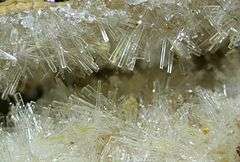Minyulite
| Minyulite | |
|---|---|
|
Colorless minyulite chrystals from Tom's Phosphate quarry, Kapunda, Mount Lofty Ranges, South Australia (Field of view 4 mm) | |
| General | |
| Category | Phosphate mineral |
| Formula (repeating unit) | KAl2(OH,F)(PO4)2·4(H2O) |
| Strunz classification | 08.DH.05 |
| Crystal system | Orthorhombic |
| Space group |
Orthorhombic pyramidal H-M symbol: mm2 Space group: Pba2 |
| Unit cell | a = 9.34 Å, b = 9.74 Å, c = 5.52 Å; Z = 2 |
| Identification | |
| Formula mass | 372.57 g |
| Color | Colorless to white, greenish yellow |
| Crystal habit | Radiating fibrous to prismatic crystals |
| Cleavage | {001} Perfect |
| Fracture | Uneven - Flat surfaces (not cleavage) fractured in an uneven pattern. |
| Tenacity | Brittle |
| Mohs scale hardness | 3.5 |
| Luster | Vitreous, silky in aggregates |
| Streak | White |
| Diaphaneity | Transparent |
| Specific gravity | 2.45 |
| Optical properties | Biaxial (+) |
| Refractive index | nα = 1.531 nβ = 1.534 nγ = 1.538 |
| Birefringence | δ = 0.007 |
| 2V angle | Measured: 70° , calculated: 82° |
| References | [1][2][3] |
Minyulite is a rare phosphate mineral with a chemical formula of KAl2(OH,F)(PO4)2·4(H2O).[2]
It occurs as groups of radiating fine fibrous crystals within rock cracks of phosphatic ironstone. Minyulite belongs to the orthorhombic crystal system. This indicates that it has three axes of unequal length yet all are perpendicular to each other. It's cell constants are a=9.35, b=9.74 c=5.52.[4]
As for its optical properties, Minyulite is an anisotropic mineral which means the velocity of light differs when traveling through it depending on the cut of its cross section which gives it more than one refractive index.[5] The mineral is optically biaxial. Its birefringence value is 0.007.[6] It has three refractive indices which are nα=1.531 nβ=1.534 nγ=1.538.[7] Refractive indices are a ratio of the speed of light in a median with respect to the speed of light passing through the mineral.[5]
Occurrence

It was first described in 1933 for an occurrence in Western Australia and named after the type locality, Minyulo Well in Western Australia.[1]
Minyulite is considered as a secondary phosphate since it is formed by the alteration of a primary phosphate. It occurs in association with dufrenite, apatite, fluellite, wavellite, variscite and leucophosphite.[2]
The mineral can be found in the underlying phosphatized rock zone of ornithogenic soil. Minyulite is not found in abundance, it can be found in the sea shore of the maritime Arctic.[8]
References
- 1 2 Minyulite at Mindat
- 1 2 3 Handbook of Mineralogy
- ↑ Webmineral data
- ↑ Kampf, A.R. (1977) Minyulite: its atomic arrangement. American Mineralogist, 62, 256–262.
- 1 2 Klein, C., and Dutrow, B.(2007) The 23rd Edition of the Manual of Mineral Science, 290 p. John Wiley and Sons, Inc. Hoboken, New Jersey,U.S.A.
- ↑ Spencer, L.J., F.A. Bannister, M.H. Hey, and H. Bennett (1943) Minyulite (hydrous K-Al fluophosphate) from South Australia. Mineralogical Magazine, 26, 309–314.
- ↑ Simpson, E.S., and Le Mesurier, C.R.(1933)Minyulite: a new phosphate mineral from Dandaragn. Journal of the Royal Society of Western Australia: 19-13.
- ↑ Tatur, A., and Keck, A. (1990) Phosphates in ornithogenic soils of the Maritime Antarctic.Proc. NIPR Symp. Polar Biol: 3, 133-150.
| Wikimedia Commons has media related to Minyulite. |
